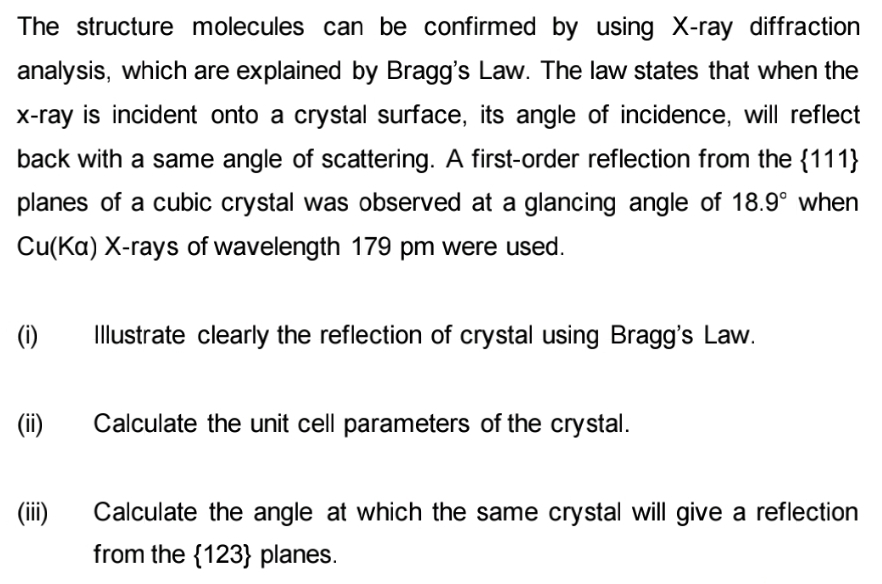The structure molecules can be confirmed by using X-ray diffraction analysis, which are explained by Bragg's Law. The law states that when the x-ray is incident onto a crystal surface, its angle of incidence, will reflect back with a same angle of scattering. A first-order reflection from the {111} planes of a cubic crystal was observed at a glancing angle of 18.9° when Cu(ka) X-rays of wavelength 179 pm were used. (i) Illustrate clearly the reflection of crystal using Bragg's Law. (ii) Calculate the unit cell parameters of the crystal. Calculate the angle at which the same crystal will give a reflection from the {123} planes.
The structure molecules can be confirmed by using X-ray diffraction analysis, which are explained by Bragg's Law. The law states that when the x-ray is incident onto a crystal surface, its angle of incidence, will reflect back with a same angle of scattering. A first-order reflection from the {111} planes of a cubic crystal was observed at a glancing angle of 18.9° when Cu(ka) X-rays of wavelength 179 pm were used. (i) Illustrate clearly the reflection of crystal using Bragg's Law. (ii) Calculate the unit cell parameters of the crystal. Calculate the angle at which the same crystal will give a reflection from the {123} planes.
Physical Chemistry
2nd Edition
ISBN:9781133958437
Author:Ball, David W. (david Warren), BAER, Tomas
Publisher:Ball, David W. (david Warren), BAER, Tomas
Chapter22: Surfaces
Section: Chapter Questions
Problem 22.36E
Related questions
Question
Kindly answer this question i, ii & iii

Transcribed Image Text:The structure molecules can be confirmed by using X-ray diffraction
analysis, which are explained by Bragg's Law. The law states that when the
x-ray is incident onto a crystal surface, its angle of incidence, will reflect
back with a same angle of scattering. A first-order reflection from the {111}
planes of a cubic crystal was observed at a glancing angle of 18.9° when
Cu(Ka) X-rays of wavelength 179 pm were used.
(i)
Illustrate clearly the reflection of crystal using Bragg's Law.
(ii)
Calculate the unit cell parameters of the crystal.
(iii)
Calculate the angle at which the same crystal will give a reflection
from the {123} planes.
Expert Solution
This question has been solved!
Explore an expertly crafted, step-by-step solution for a thorough understanding of key concepts.
Step by step
Solved in 2 steps with 2 images

Knowledge Booster
Learn more about
Need a deep-dive on the concept behind this application? Look no further. Learn more about this topic, chemistry and related others by exploring similar questions and additional content below.Recommended textbooks for you

Physical Chemistry
Chemistry
ISBN:
9781133958437
Author:
Ball, David W. (david Warren), BAER, Tomas
Publisher:
Wadsworth Cengage Learning,

Chemistry: The Molecular Science
Chemistry
ISBN:
9781285199047
Author:
John W. Moore, Conrad L. Stanitski
Publisher:
Cengage Learning

Physical Chemistry
Chemistry
ISBN:
9781133958437
Author:
Ball, David W. (david Warren), BAER, Tomas
Publisher:
Wadsworth Cengage Learning,

Chemistry: The Molecular Science
Chemistry
ISBN:
9781285199047
Author:
John W. Moore, Conrad L. Stanitski
Publisher:
Cengage Learning